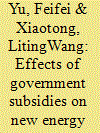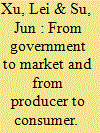|
|
|
Sort Order |
|
|
|
Items / Page
|
|
|
|
|
|
|
| Srl | Item |
| 1 |
ID:
175037


|
|
|
|
|
| Summary/Abstract |
In this study, subsidies are classified into government subsidies beforehand (GSB) and government subsidies afterwards (GSA). We examine the impacts of GSB and GSA on the financial performance of Chinese enterprises of New Energy Vehicle (NEV). Analyzing a dataset of Chinese NEV firms' financial performance from 2013 to 2017 with panel regression models, we demonstrate that the two forms of government subsidies have different impacts on New Energy Vehicle enterprises' performance. Specifically, we find a positive U-shaped relationship between GSB and financial performance and an inverted one between GSA and financial performance. We further investigate the moderating role of intelligent transformation in the relationships between government subsidies and NEV enterprises’ performance. Our empirical analysis suggests that intelligent transformation can improve the efficiency of GSA and weaken the negative effects of excessive GSA. These results highlight the importance of intelligent transformation for NEV enterprises, providing policy makers with new insights into NEV subsidy policies.
|
|
|
|
|
|
|
|
|
|
|
|
|
|
|
|
| 2 |
ID:
177311


|
|
|
|
|
| Summary/Abstract |
Since 1994, to overcome adoption barriers and promote new energy vehicles (NEVs), eight cities and one province in China have implemented a license plate quota policy for internal combustion engine vehicles (ICEVs). We use a city-level dataset of NEV sales to assess the impact of license plate quota policy for ICEVs on the adoption of NEVs, by using both the synthetic control method (SCM) and difference-in-differences (DID) method for the first time. We find that license plate quota policy can significantly increase the annual sales of NEVs in Tianjin, Hangzhou, Shenzhen, and Haikou by approximately 73.4%, 87.5%, 87%, and 65.5% of total sales of NEVs, which is equivalent to increasing the annual sales of NEVs by 15,557, 22,267, 37,455, and 448 vehicles, respectively. Further, our findings indicate that a license plate quota policy for ICEVs promotes the adoption of NEVs but has certain limitations, for example, license plate quota policy has a short-term inhibitory effect on the regional auto industry. Moreover, due to the restraint on consumers from purchasing ICEVs, consumers have certain negative sentiment toward the policy based on text analysis. Regions where license plate quota policy is adopted generally required well-developed public transportation and adequate charging infrastructures.
|
|
|
|
|
|
|
|
|
|
|
|
|
|
|
|
| 3 |
ID:
150013


|
|
|
|
|
| Summary/Abstract |
This paper proposes a new typology that classifies innovation policy instruments into two dimensions: government-selection versus market-selection, and producer-orientation versus consumer-orientation. Such a typology articulates the importance of consumer behavior in the policy design for a transition, and the relevance for the market to select target subjects of policy during the deployment stage of clean technology innovation. We apply this typology to policy instruments of China's new energy vehicle (NEV) industry between 1991 and 2015 in order to explain the industry's rapid growth. The focus of China's policy mix has transited from government-selection to market-selection, and from producer-orientation to consumer-orientation. Other than the new typology, this paper traces the entire history of policy transition within China's NEV industry, and finds the transition to be a result of policy learning, thus contributing to future empirical studies of this industry.
|
|
|
|
|
|
|
|
|
|
|
|
|
|
|
|
| 4 |
ID:
186488


|
|
|
|
|
| Summary/Abstract |
Due to the increasingly severe energy crisis and rising environmental pollution, as an environmentally friendly travel tool, the development of new energy vehicles (NEVs) has been vigorously pursued in many countries. The Chinese government put forward “Parallel Management Measures for the Average Fuel Consumption of Passenger Vehicle Enterprises and Credits for New Energy Vehicles” (referred to as the “dual credit policy”) to promote NEVs. Under the dual credit policy, enabling the NEV supply chain to make research and development (R&D) optimization decisions with capital constraints is a vital issue. Based on the dual credit policy, this study proposes an R&D decision model, incorporating suppliers’ capital constraints, to obtain the optimal strategy for addressing such constraints and promoting NEV development. The results of this study indicate that the dual credit policy promotes the development of the NEV industry whereas the capital constraints weaken the incentive effect of the policy. We propose two solutions, taking bank loans and sharing the cost with manufactures, to relieve the financial constraints. Furthermore, we put forward the conditions for choosing the optimal one. With the increase in the loan interest rate, the credit price, and the technology improvement credit coefficients, suppliers should choose the solution of sharing cost with manufactures. Otherwise, loan strategy is more acceptable.
|
|
|
|
|
|
|
|
|
|
|
|
|
|
|
|
|
|
|
|
|